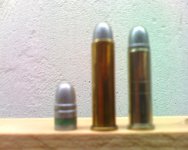David Sinko
Member
I just traded a couple of bags of lead shot to a local bullet caster for a good quantity of .357" 158 gr. LRN. The bullets are excellent quality and while most will be loaded in .38 Special, I loaded some in .357 Magnum brass with a charge of 2400 as "Revolver Major" match loads. I dropped a loaded .357 moonclip into the cylinder and it would not close. Strange. No high primers. No fouled chambers. No bulged brass. So why wouldn't the cylinder close? Then I see it... The bullets are sticking out past the cylinder! How can this be? Who cuts a mold for a bullet that won't fit into a .357 Magnum cylinder? I then checked them in the cylinder of my Model 66 and they did fit, but just barely. Why is the cylinder of the 627 so short?
Next I loaded one with the bullet seated deeper and crimped over the front driving band. Now it fits into the 627, but the OAL is almost the same as a .38 Special with the bullet crimped normally. So what's the better alternative when loading with 2400? Seat the bullet deep into the .357 Magnum brass or seat it to normal depth in the .38 Special? Which will produce the lower pressure? Does it even matter?
Dave Sinko
Next I loaded one with the bullet seated deeper and crimped over the front driving band. Now it fits into the 627, but the OAL is almost the same as a .38 Special with the bullet crimped normally. So what's the better alternative when loading with 2400? Seat the bullet deep into the .357 Magnum brass or seat it to normal depth in the .38 Special? Which will produce the lower pressure? Does it even matter?
Dave Sinko

